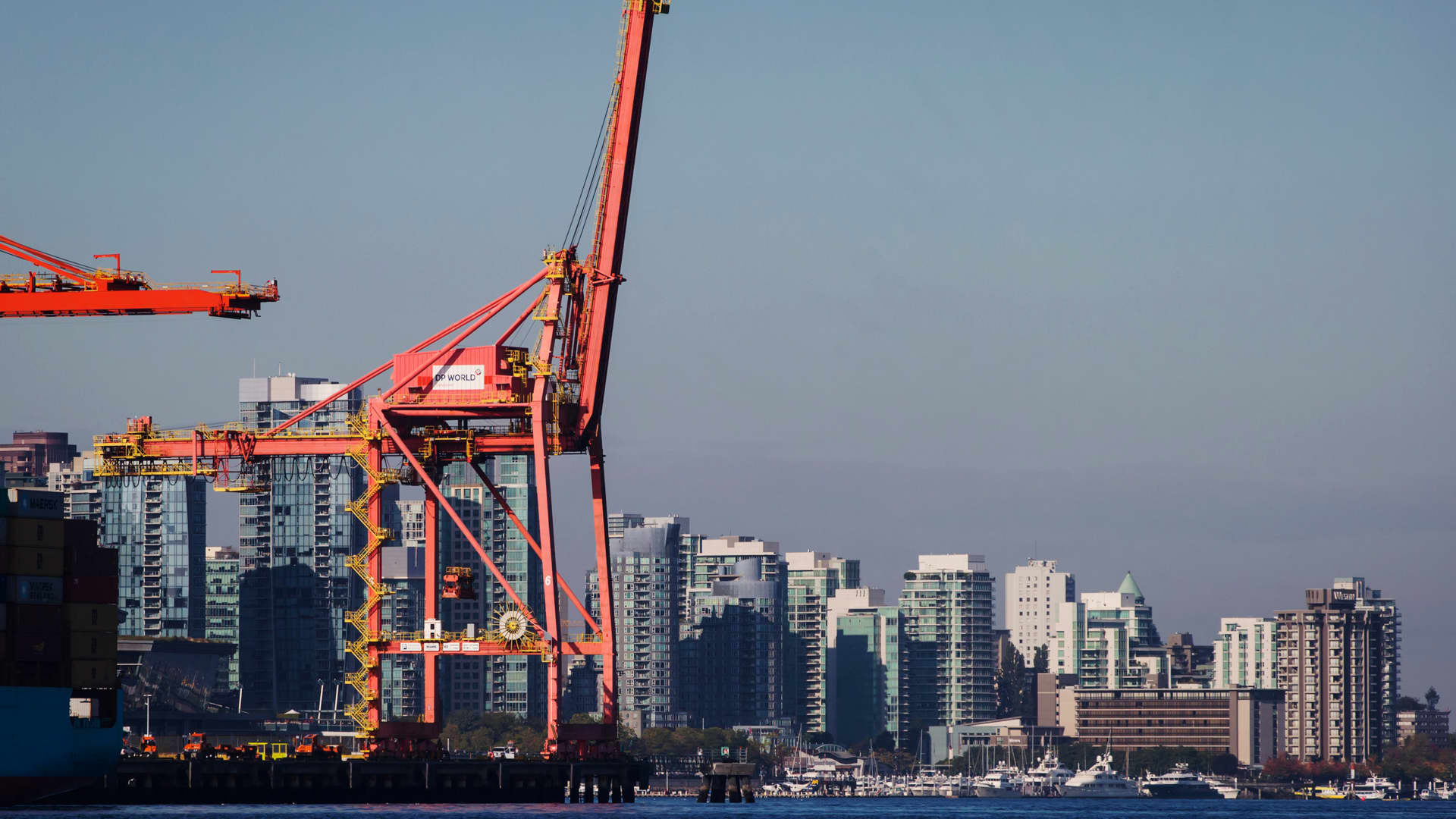A gantry crane stands in the DP World Ltd. terminal at Port Metro Vancouver in Vancouver, British Columbia, Canada, on Wednesday, Sept. 19, 2018.
Darryl Dyck | Bloomberg | Getty Images
The strike at the Canada’s West Coast ports is over, after both the labor union and port ownership accepted a deal presented by federal mediators. ILWU Canada union workers were expected to be back on the job for the 4:30 p.m. Pacific time shift on Thursday, but undoing the damage to the supply chain from close to two weeks of strike will take weeks.
In a statement posted to Twitter announcing that a deal had been reached, Canadian Labor Minister Seamus O’Regan and Transport Minister Omar Alghabra said, “The scale of this disruption has been significant.”
While the production ramp down at the ports was seen immediately, the congestion as a result of the 13-day strike will have a lasting effect on ports. The ramping back up takes weeks before efficiencies will be regained. By combing the wait time of vessels getting into port and unloaded, and containers loaded onto the rails, combined delays can extend from a month to at least two months for a U.S. arrival.
The International Longshoremen and Warehouse Union of Canada begin its strike on July 1. Negotiations between the ILWU Canada and the British Columbia Maritime Employers Association were tense, but O’Regan saw differences as bridgeable, leading him to push federal mediators on Tuesday to come up with a proposal both sides could agree to.
With no vessels serviced for 13 days, according to VesselsValue, the number of vessels waiting at Prince Rupert are four, and the number of vessels waiting to enter Vancouver at nine. The combined value of trade floating offshore is $7.5 billion. There were more vessels waiting, but they left anchorage to go to U.S. ports.
Supply chain impacts
In a recent HLS Transpacific Market Report, the company warned clients that the work stoppage at the terminals has delayed the loading and transfer of the containers to railways. “As 15% of import volume going through Vancouver and around 65% of Prince Rupert volume are sent to the US destinations, the US Inland Port Intermodal routings will be heavily impacted,” it wrote.
HLS said shippers are expected to reroute some imports to U.S. West Coast ports. Carriers have cancelled callings at Vancouver and Prince Rupert, which also means further vessel capacity cuts.
The ports strike has already damaged the U.S. supply chain. In data released Wednesday, the American Association of Railroads reported year-over-year intermodal Canadian rail was down almost 50% last week as a result of the strike. The top sectors impacted included forest products such as lumber and wood products, oil and petroleum products, non-metallic minerals such as crushed stone, sand, stone, clay, and glass products, and chemicals. Products that go into paints, coatings as well as acids from Asia, were the most impacted, according to the National Association of Chemical Distributors.
The National Association of Chemical Distributors told CNBC its members likely have tens of millions of dollars in inventory stuck on ships outside of the Port of Vancouver.
“Many of our members are re-booking through U.S. West Coast ports with the likelihood of an extra 10-14 days of ground transit time because of the redirect,” said Eric Byer, CEO of the National Association of Chemical Distributors. “Some member company products have been on the water since June 30 and other arrivals earlier this month are now not being slated to be unloaded until early to mid-August at the earliest,” he said.
Products stuck on the water include essential food additives such as dextrose, guar gum & sorbates, citric acid — agriculture, food, cleaning/HI&I, personal care, sodium sulfite & sodium metabisulfite — water purification, dry caustic soda — used in metal working, food equipment cleaning, and a variety of other applications — and iron oxide, which is used as a pigment. Byer said one member company informed him it is now planning for an extended supply chain disruption through October for Canada.
Billions of dollars in trade tied up
Approximately $572 million in container trade arrives daily in the U.S. from Canada, according to U.S. Census data. Between January 2022 and May 2023, total monthly U.S. goods imported from Canada ranged from $31 billion to nearly $41 billion. Top commodity imports for May included mineral fuels, vehicles, and computer-related machinery. Holiday items, sneakers, apparel, and home goods are also being imported into Canadian ports for U.S. companies.
The U.S. and Canada have a historically strong trade relationship: Each country is the other’s top trading partner. Approximately 20% of U.S. trade arrives in the Canadian ports of Vancouver and Prince Rupert, where strikes broke out after union leadership and industry representatives failed to reach a deal before a cooling-off period expired. The Canadian Chamber of Commerce estimates $605 million in trade moves through one of those two ports daily.
During the strike, it was estimated that it would take three to five days for every day the strike lasted for networks and supply chains to recover, according to the Railway Association of Canada. With the strike ending on its thirteenth day, delays for rail containers can be anywhere from 39 to 66 days. This does not include the delays in vessels waiting to get processed, which would add multiple additional delays.
The British Columbia Maritime Employers Association said in a statement after the deal was announced that it “regrets the significant impact this labour disruption has had on the economy, businesses, workers, customers and ultimately, all Canadians. We must collectively work together to not only restore cargo operations as quickly and safely as possible but to also rebuild the reputation of Canada’s largest gateway and ensure supply chain stability and resilience for the future.”
ILWU Canada could not be immediately reached for comment.
Vessel diversions to U.S. continue
There are now five vessels identified by eeSea that diverted away from Vancouver to U.S. ports — the MSC Sara Elena, Ever Safety, COSCO Africa, Calandra, and MSC Brunella. These five vessels have been worked on by ILWU U.S. West Coast workers.
ILWU president Willie Adams, visited Canada a second time since July 4 to attend a union rally Sunday. He told CNBC in a recent statement that union workers will not serve any rediverted vessels, but there are situations in which it is difficult for union workers to know the origin of cargo.
Logistics managers have been able to reassign the destination of containers from Canada to the United States on vessels. It takes around five days for the changes to be made. U.S. Customs also needs to be alerted and approve the container. One way the union can be alerted to diverted containers is by the number of containers being unloaded on a vessel.

Vessels regularly arrive at the same ports and there is a ballpark number of containers that are unloaded. If 500 containers are normally unloaded, and the current port call now has 900, chances are there are diverted containers on the vessels. Other than that, it would be difficult for the ILWU to identify containers that had their final destinations changed because union workers do not have access to container information for security reasons.
The rash of vessels flipping their port schedules, leaving Vancouver for U.S. ports to supposedly go back to Vancouver has increased to nine, according to eeSea. The schedule can change after being discharged at the U.S. port service. It’s likely that many of the vessels that flipped their schedules will not go back to Canada. That is what happened with the MSC Sara Elena, which was worked on in Seattle. After the service, the carrier announced it would not be heading back to Vancouver, which means the Canadian-bound freight was unloaded or will be unloaded in future U.S. ports.
Key sticking points in the talks included the assignment of work to third-party companies and wages. The ILWU has stressed wages are not keeping up with inflation. It says the real purchasing power of longshore wages has fallen 2.5% since 2017, and longshore wages have grown slower than wages in the overall Canadian economy.
No terms of the deal were disclosed.
On Wednesday, the Bank of Canada raised its benchmark interest rate to a 22-year high, of 5%, and provided hawkish commentary about more hikes potentially being needed in its effort to fight inflation, even as consumer prices have come down from last year’s highs.

